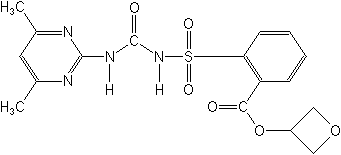-
Common NameOxasulfuron
-
中文通用名环氧嘧磺隆
-
IUPACoxetan-3-yl 2-[(4,6-dimethylpyrimidin-2-yl)carbamoylsulfamoyl]benzoate
-
CAS3-oxetanyl 2-[[[[(4,6-dimethyl-2-pyrimidinyl)amino]carbonyl]amino]sulfonyl]benzoate
-
CAS No.144651-06-9
-
Molecular FormulaC17H18N4O6S
-
Molecular Structure
-
Category
-
ActivityHerbicide.Oxasulfuron is a short-residual herbicide that has to be applied post-emergence of the crops. It is taken up by the roots and shoots and translocated to the meristematic tissue. Treated weeds die 1-3 weeks after application. Optimum weed control is obtained in damp conditions. Weeds that are not killed are severely stunted and do not compete with the soybean crop. Oxasulfuron is rainfast within four hours of application. A surfactant, such as X-77, should be tank-mixed with the herbicide for optimum activity. Oxasulfuron is safe to rotational crops. Novartis recommends its use in an integrated soybean weed control programme with other pre- and post-emergence products. The product can be tank-mixed with other post-emergence soybean herbicides (including acifluorfen, lactofen and bentazone) although not post-emergence graminicides.
-
CropUseCropUses:
soybeans
Soybeans
45-80 g ai/ha
-
Physical PropertiesMolecular weight:406.4g/mol; Physical form:White, odourless powder. Density:1.41; Melting point:158℃ ( decomp.); Vapour pressure:<2 × 10-3 mPa (25 ℃); Henry constant:<3.2 × 10-5 Pa m3 mol-1 (calc.); Partition coefficient(n-octanol and water):logP = 0.75 ( pH 5), -0.81 ( pH 7), -2.2 ( pH 8.9); pKa:5.1; Solubility:In water 52 ppm ( pH 5.1, 25℃); in buffer, 63 ( pH 5.0), 1700 ( pH 6.8), 19 000 ( pH 7.8) mg/l (15℃). In methanol 1500, acetone 9300, toluene 320.
-
ToxicologyOral:Acute oral LD50 for rats >5000 mg/ kg. Percutaneous:Acute percutaneous LD50 for rabbits >2000 mg/kg. No skin or eye irritation (rabbits). Not a skin sensitiser (guinea pigs). Inhalation: LC50 for rats >5.08 mg/l air. ADI:( JMPR) 0.03 mg/ kg b.w. [1985].
-
Environmental ProfileWATER SOLUBILITY: 280 g/l at 25℃ HAZARDS: Fish: LC50 >111 mg/l (bluegill sunfish); >116 mg/l (trout). Bird: Oral LD50 >2250 mg/kg (mallard duck, quail). Bee: Nontoxic. LD50 >25 μg/bee
Bobwhite quail
LD50 >2,250 mg/kg
Mallard duck
LD50 >2,250 mg/kg
Bluegill sunfish [96 hrs]
LC50 >111 mg/litre
Rainbow trout [96 hrs]
LC50 >116 mg/litre
Bee
LD50 >25 μg/bee
Fate in soil:
The half-life of oxasulfuron in soil is less than two weeks. It is degraded microbially and chemically. The rate of degradation is independent of soil conditions.Fate in aquatic systems:
The half-life of oxasulfuron in aquatic systems is approximately 12 days. Its solubility increases with increasing pH. -
Transport InformationSignal Word:CAUTION; Hazard Class:III(Slightly hazardous)
Porduct NewsMore
Orthosulfamuron boosts sugarcane production, study finds
Glyphosate price plummets 40% in one year in Argentina
Indian govt stops imports of herbicide Glufosinate priced below Rs 1,289 per kg
Carbendazim fungicide wins victory in Brazilian Parliament
Corteva presents new pre-emergent herbicide Linear for sugarcane in Brazil
Picloram Triclopyr Aminopyralid
Revolutionizing disease prevention: BASF launches new rice fungicide Cevya® in China
Thiamethoxam is allowed again in Brazil by a judicial decision
Bayer develops alternative to glyphosate herbicide
Related CompaniesMore
Shenzhen Baocheng Chemical Industry CO.,LTD.
Country: China
Glyphosate Emamectin benzoate Lambda-cyhalothrin Pyraclostrobin Bromacil Glufosinate-ammonium Tembotrione Prothioconazole Topramezone Chlorantraniliprole

 0
0 Subscribe
Subscribe
